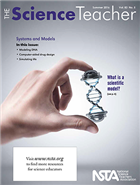Right to the Source: Sketching the Double Helix
By sstuckey
Posted on 2016-08-10
Exploring Science and History With the Library of Congress.
In 1869, 25-year-old Swiss physician Friedrich Miescher first identified and isolated deoxyribonucleic acid (DNA), calling it nuclein. Decades later, scientists identified the DNA molecule’s role in determining genetic inheritance. But not until 1953 was DNA’s distinctive double-helix structure discovered by James Watson and Francis Crick. Working at the Cavendish Laboratory at Cambridge University, they used tools as simple as pencil sketches and handmade physical models to form their ideas.
In his 1988 book, What Mad Pursuit, Crick explained: “Our first attempt at a model was a fiasco.” But later models and sketches,
including the one shown here, helped them visualize possibilities and test solutions, which led to demonstrations, illustrations, and diagrams through which they shared their findings with others.
One such diagram appeared in a 1953 article in Nature in which the two young scientists (Watson, 23, and Crick, 35) announced: “We wish to suggest a structure for the salt of [DNA]. This structure has novel features which are of considerable biological interest.”
Stating that their model was “radically different” from those proposed by other scientists, Watson and Crick described DNA’s structure as a double helix with the bases pointing in and forming pairs of adenine (A) with thymine (T), and cytosine (C) with guanine (G). The small, “purely diagrammatic” figure that they included (drawn by Crick’s wife, Odile, and similar to the pencil sketch), showed how the components of DNA fit together.
They acknowledged the need for more experimental data and asserted, “It has not escaped our notice that the specific pairing we have postulated immediately suggests a possible copying mechanism for the genetic material.”
They were right. Knowing the structure of DNA is, in fact, the key to understanding how genetic information is copied and passed along to future generations.
About the Source
The double-helix sketch shown above is available online at the World Digital Library (WDL), a project of the U.S. Library of Congress with support from the United Nations Educational, Cultural and Scientific Organization (UNESCO) and in cooperation with libraries, archives, museums, educational institutions, and international organizations around the world. The WDL makes available online significant primary materials from all countries and cultures. The original sketch is part of the Francis Crick papers housed at the Wellcome Library for the History and Understanding of Medicine in London. The library’s online research resource entitled “Codebreakers: Makers of Modern Genetics” features the digitized papers of 22 scientists and organizations. Most of Crick’s personal papers are housed at the University of California–San Diego. The complete James Watson Papers are housed at the Cold Spring Harbor Laboratory Archives in New York.
Related Student Explorations
- Scientific models
- Peer-reviewed scientific journals
- X-ray crystallography
- Rosalind Franklin, Linus Pauling, Maurice Wilkins, Jerry Donohue (other scientists involved with DNA research)
Lee Ann Potter is the director of Educational Outreach at the Library of Congress.
Editor’s Note
This article was originally published in the Summer 2016 issue of The Science Teacher journal from the National Science Teachers  Association (NSTA).
Association (NSTA).
Get Involved With NSTA!
Join NSTA today and receive The Science Teacher, the peer-reviewed journal just for high school teachers; to write for the journal, see our Author Guidelines and Call for Papers; connect on the high school level science teaching list (members can sign up on the list server); or consider joining your peers at future NSTA conferences.
The mission of NSTA is to promote excellence and innovation in science teaching and learning for all.
Future NSTA Conferences
2016 Area Conferences
2017 National Conference
Follow NSTA
Disclaimer: The views expressed in this blog post are those of the author(s) and do not necessarily reflect the official position of the National Science Teaching Association (NSTA).


